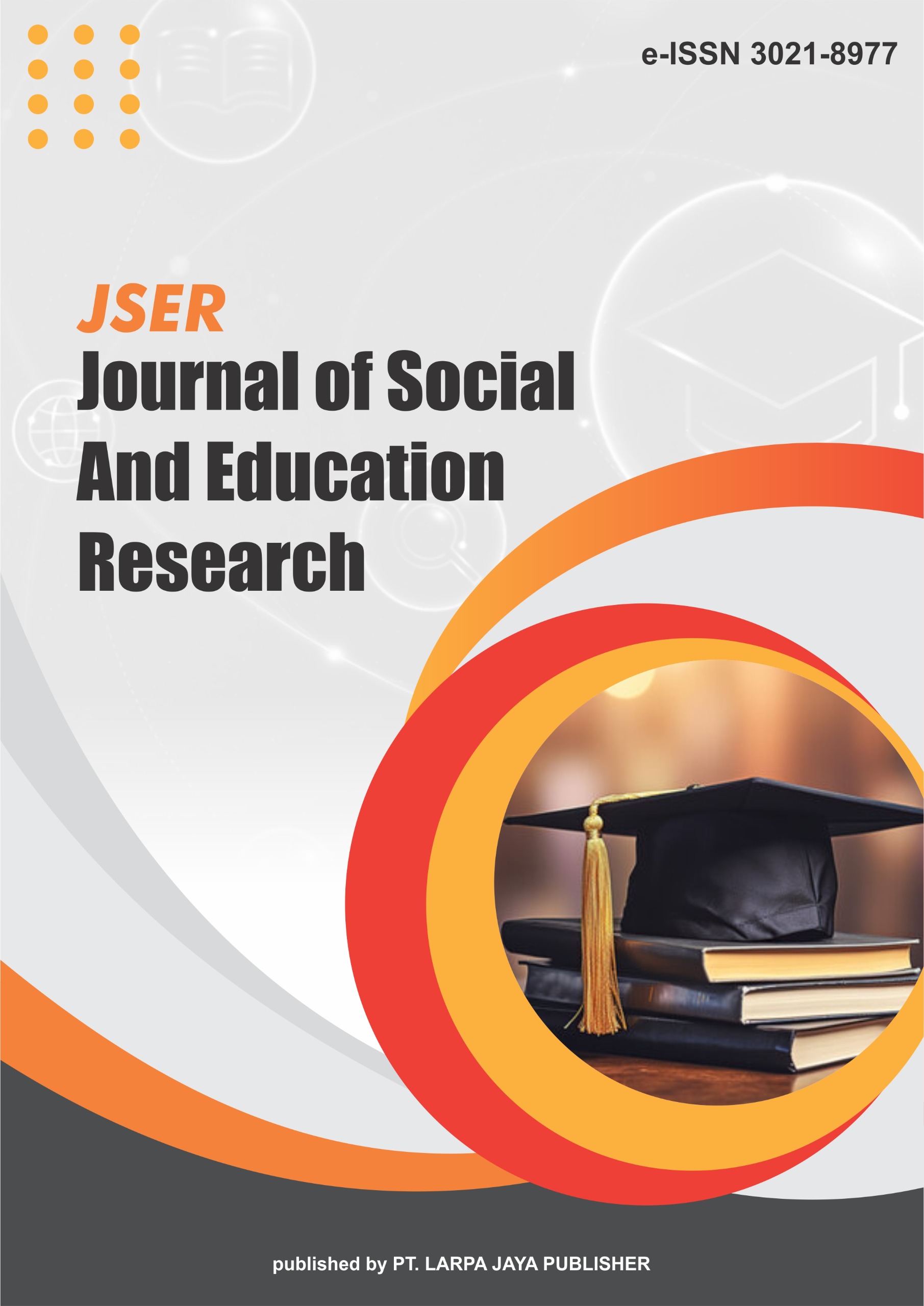The Social Construction of Dogs and Its Implications for Rabies Prevention Strategies
DOI:
https://doi.org/10.63265/jser.v1i3.158Keywords:
rabies prevention, social construction, dogs, community behavior, vaccination, public healthAbstract
Rabies remains a significant public health concern, particularly in regions with high dog populations. This study examines how social constructions of dogs influence rabies prevention strategies, focusing on community perceptions, cultural norms, and human–dog interactions. A systematic review of 15 studies published between 2010 and 2023 was conducted to identify factors affecting responsible dog ownership, vaccination uptake, and public engagement in rabies control. The findings indicate that social and cultural beliefs significantly shape behaviors related to dog management, including vaccination compliance and post-exposure practices. Effective rabies prevention requires integrating biomedical interventions with culturally sensitive approaches, community participation, and education programs that address local perceptions of dogs. Policies that respect community norms while promoting responsible ownership and vaccination are crucial for sustainable rabies control. The study highlights that understanding the social construction of dogs provides a comprehensive framework for designing inclusive, context-specific, and effective rabies prevention strategies.
References
Bardosh, K., Sambo, M., Sikana, L., Hampson, K., Welburn, S. C., & Cleaveland, S. (2016). Eliminating rabies in Tanzania: Local understandings and responses to mass dog vaccination in Kilombero and Ulanga districts. PLoS Neglected Tropical Diseases, 10(9), e0004936. https://doi.org/10.1371/journal.pntd.0004936
Cleaveland, S., Lankester, F., Townsend, S., Lembo, T., & Hampson, K. (2018). Rabies control and elimination: A test case for One Health. Veterinary Record, 182(14), 431–434. https://doi.org/10.1136/vr.k321
Davlin, S. L., & Vonville, H. M. (2012). Canine rabies vaccination and domestic dog population characteristics in the developing world: A systematic review. Vaccine, 30(24), 3492–3502. https://doi.org/10.1016/j.vaccine.2012.03.069
Durr, S., Mindekem, R., Kaninga, Y., Doumagoum Moto, D., Meltzer, M. I., Vounatsou, P., & Zinsstag, J. (2017). Effectiveness of dog rabies vaccination programmes: Comparison of owner-charged and free vaccination campaigns. Epidemiology and Infection, 145(14), 3048–3057. https://doi.org/10.1017/S0950268817002122
Hampson, K., Coudeville, L., Lembo, T., Sambo, M., Kieffer, A., Attlan, M., & Cleaveland, S. (2015). Estimating the global burden of endemic canine rabies. PLoS Neglected Tropical Diseases, 9(4), e0003709. https://doi.org/10.1371/journal.pntd.0003709
Knobel, D. L., Banyard, A. C., Cleaveland, S., Fooks, A. R., & Hayman, D. T. S. (2020). Rabies and the challenge of cross-sectoral governance. Trends in Parasitology, 36(7), 606–618. https://doi.org/10.1016/j.pt.2020.04.004
Ostrowski, S., Janelle, J., & Suraud, R. (2018). Dogs, religion, and rabies in the Middle East: A human-animal relationship at a crossroads. Anthrozoös, 31(3), 343–357. https://doi.org/10.1080/08927936.2018.1455459
Serpell, J. (2019). The domestic dog: Its evolution, behavior, and interactions with people (2nd ed.). Cambridge University Press.
Sugiyama, T., & Thompson, C. W. (2013). Outdoor environments, activity, and the well-being of older people: Conceptualising environmental support. Environment and Planning A, 45(1), 97–114. https://doi.org/10.1068/a45420
World Health Organization. (2018). Zero by 30: The global strategic plan to end human deaths from dog-mediated rabies by 2030. WHO Press.
Buchanan, R. (2019). The role of dogs in rural communities: Balancing cultural values and public health in rabies prevention. Journal of Community Health, 44(5), 890–899. https://doi.org/10.1007/s10900-019-00671-2
Cleaveland, S., Sharp, J., Abela-Ridder, B., Allan, K. J., Buza, J., Crump, J. A., & Hampson, K. (2020). One Health contributions towards more effective and equitable approaches to health in low- and middle-income countries. Philosophical Transactions of the Royal Society B, 375(1814), 20190166. https://doi.org/10.1098/rstb.2019.0166
Hossain, M., Ahmed, S., & Karim, M. R. (2020). Socio-cultural beliefs and practices influencing rabies prevention in rural Bangladesh. PLOS Neglected Tropical Diseases, 14(2), e0008089. https://doi.org/10.1371/journal.pntd.0008089
Morters, M. K., Restif, O., Hampson, K., Cleaveland, S., Wood, J. L. N., & Conlan, A. J. K. (2013). Evidence-based control of canine rabies: A critical review of population density reduction. Journal of Animal Ecology, 82(1), 6–14. https://doi.org/10.1111/j.1365-2656.2012.02033.x
Rao, A. M., & Kennedy, N. (2021). Community engagement and behavioral change for effective rabies prevention in India. Tropical Medicine and Infectious Disease, 6(2), 92. https://doi.org/10.3390/tropicalmed6020092
Taylor, L. H., Knopf, L., & Nel, L. H. (2022). Eliminating canine rabies: The role of social science in understanding dog–human relationships. Frontiers in Veterinary Science, 9, 839222. https://doi.org/10.3389/fvets.2022.839222
Abdul Rahim, N., Abdullah, S., Rahman, H. A., & Hashim, A. (2023). The determinants of rabies knowledge, attitudes, and practices among dog owners in the North-Eastern Region of Peninsular Malaysia. BMC Veterinary Research, 19(1), 245. https://doi.org/10.1186/s12917-023-03591-8
Aliaga-Samanez, A., Castillo-Neyra, R., Buttenheim, A. M., Paz-Soldan, V. A., & Levy, M. Z. (2018). Barriers to dog rabies vaccination during an urban rabies outbreak: Qualitative findings from Arequipa, Peru. PLoS Neglected Tropical Diseases, 12(3), e0006291. https://doi.org/10.1371/journal.pntd.0006291
Cleaveland, S., Sharp, J., Abela-Ridder, B., Allan, K. J., Buza, J., & Hampson, K. (2018). One Health contributions towards more effective and equitable rabies control: The example of Tanzania. Veterinary Sciences, 5(2), 52. https://doi.org/10.3390/vetsci5020052
Davlin, S. L., Lapiz, S. M. D., Miranda, M. E. G., Murray, K. O., & Meltzer, M. I. (2014). Factors associated with dog rabies vaccination coverage in Bohol, Philippines: Implications for elimination of canine rabies. PLoS Neglected Tropical Diseases, 8(6), e2950. https://doi.org/10.1371/journal.pntd.0002950
Hampson, K., Coudeville, L., Lembo, T., Sambo, M., Kieffer, A., Attlan, M., & Global Alliance for Rabies Control Partners for Rabies Prevention (2015). Estimating the global burden of endemic canine rabies. PLoS Neglected Tropical Diseases, 9(4), e0003709. https://doi.org/10.1371/journal.pntd.0003709
Knobel, D. L., Cleaveland, S., Coleman, P. G., Fevre, E. M., Meltzer, M. I., Miranda, M. E. G., ... & Meslin, F. X. (2014). Re-evaluating the burden of rabies: Global challenges and local solutions. The Lancet Infectious Diseases, 14(5), 369–383. https://doi.org/10.1016/S1473-3099(14)70076-7
Putra, A. A. G., Hampson, K., Girardi, J., Hiby, E., Knobel, D., & Scott-Orr, H. (2019). Response to a rabies epidemic, Bali, Indonesia, 2008–2011. Emerging Infectious Diseases, 25(12), 2295–2304. https://doi.org/10.3201/eid2512.181520
Riley, S., & Durrheim, D. N. (2013). Rabies control in rural communities: A sociocultural perspective. Tropical Medicine & International Health, 18(12), 1547–1555. https://doi.org/10.1111/tmi.12208
Setiawan, K. H., Probandari, A. N., Pamungkasari, E. P., & Tamtomo, D. G. (2018). Human behaviour in keeping dogs and its relationship to rabies. International Research Journal of Management, IT and Social Sciences, 5(6), 105–113. https://doi.org/10.21744/irjmis.v5n6.290
Tenzin, D., Sharma, B., Dhand, N. K., Tenzin, T., & Ward, M. P. (2012). Re-emergence of rabies and its control in Bhutan: A review. Zoonoses and Public Health, 59(7), 529–537. https://doi.org/10.1111/j.1863-2378.2012.01497.x
Widyastuti, M. D. W., Bardosh, K. L., Sunandar, Basri, C., Basuno, E., Jatikusumah, A., Putra, A. A. G., Rukmantara, T. A., Estoepangestie, S., Willyanto, I., & Gilbert, J. (2015). On dogs, people, and a rabies epidemic: Results from a sociocultural study in Bali, Indonesia. Infectious Diseases of Poverty, 4(30), 1–10. https://doi.org/10.1186/s40249-015-0061-1
Downloads
Published
How to Cite
Issue
Section
License
Copyright (c) 2023 Journal of Social And Education Research

This work is licensed under a Creative Commons Attribution-NonCommercial 4.0 International License.










